Overview
The article highlights nine essential branding strategies tailored for tech startups, aimed at helping them cultivate a strong brand identity while facing competitive challenges. Many founders struggle with defining their target audiences and developing unique market positions, which can lead to feelings of frustration and uncertainty. By crafting compelling brand messages and maintaining a consistent voice and tone, startups can find their footing in a crowded marketplace. Supported by research and case studies, these strategies underscore the significance of authenticity and engagement in nurturing lasting customer relationships. It's important to remember that you are not alone in this journey; many have walked this path and found success by embracing these principles.
Introduction
In a time when technology startups are emerging at an unprecedented rate, the importance of establishing a compelling brand identity cannot be overstated. Many of these fledgling companies find themselves facing intense competition and the daunting challenge of truly resonating with their target audience.
This article explores nine essential branding strategies specifically designed for tech startups, offering insights that can empower them to carve out their unique market position.
Yet, as the landscape continues to evolve, how can these startups ensure that their branding remains both relevant and authentic amidst the overwhelming noise? We understand the struggles you face, and we’re here to guide you through this journey.
RNO1: Comprehensive Branding Solutions for Tech Startups
In the fast-paced world of technology, many startups struggle with developing effective to establish a . This challenge can feel overwhelming, especially when faced with the fierce competition that defines the tech landscape. At RNO1, we understand these pain points deeply. Our are tailored specifically for technology companies, addressing their unique needs with compassion and expertise. We offer a range of services, including:
- Branding and identity development
- Website design
- UX & UI design
- SEO strategy & systems
- Performance marketing strategies
All designed to help you navigate these challenges effectively.
But we don’t just stop at providing solutions; we offer ongoing support through innovative subscription models. This approach ensures that new businesses receive continuous guidance and expertise as they adapt to the ever-evolving digital landscape. By enhancing visibility and fostering long-term partnerships, we aim to create a nurturing environment essential for sustainable growth in the tech sector.
As notes, '88% of consumers assert authenticity is essential when choosing which companies to endorse.' This insight underscores the in creating a genuine identity, especially for new ventures. Additionally, with 79% of millennials preferring brands that demonstrate sustainability, , positioning us as a vital ally for tech startups striving to thrive in a competitive environment.
We invite you to explore our featured case studies, which highlight real-world examples of the impact we’ve made. Together, we can turn into opportunities for growth and success.
Define Your Target Audience: Understanding Market Needs
Identifying your is a vital step for technology ventures, and it begins with thorough research to uncover demographics, preferences, and challenges. Many founders face the daunting task of , which can feel overwhelming. Utilizing tools like online surveys—favored by 85% of market researchers and recognized as the most used quantitative method—along with social media analytics can provide valuable insights. Creating detailed enables new businesses to better align their with the specific needs and desires of their audience. This tailored approach not only enhances the relevance of messaging but also increases the likelihood of engagement and conversion.
As we look towards 2025, understanding these dynamics will be more crucial than ever. The entrepreneurial landscape is evolving and diversifying, with over 150 million ventures globally and launching each year. to navigate this competitive environment, ensuring their [branding strategies](https://blog.rno1.com/4-essential-color-schemes-for-websites-to-enhance-user-engagement) resonate and produce meaningful outcomes. It’s important to note that 35% of new business failures are linked to a lack of demand for their solutions, underscoring the need to truly comprehend [target audience](https://blog.rno1.com/10-business-mission-statement-samples-for-tech-startups)s.
Moreover, the growing emphasis on , noted by 57% of researchers, highlights the importance of a multifaceted strategy in gaining insights. By embracing this supportive approach, founders can feel more confident in their journey, knowing they have the tools to connect with their audience and foster lasting relationships.
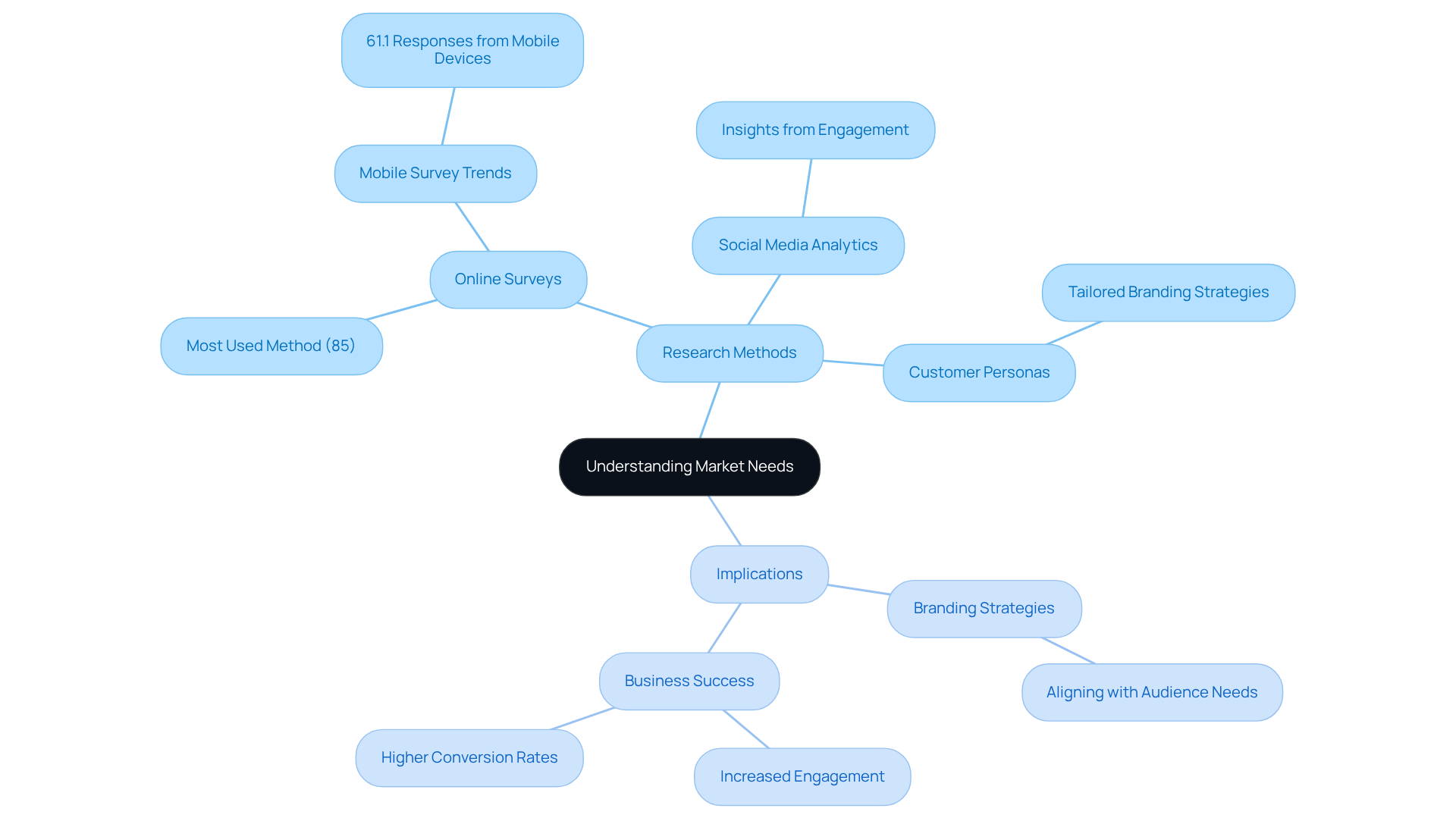
Establish a Unique Market Position: Stand Out from Competitors
In the journey of establishing a technology company, many founders face the challenge of carving out a . This can feel overwhelming, especially when navigating the complexities of competitor offerings. It's essential to conduct thorough competitor analysis to identify existing gaps in the market. By examining competitors' strengths and weaknesses, new ventures can uncover unmet needs that their products or services can fulfill, providing a sense of direction amidst uncertainty.
Developing a compelling (USP) is crucial in this process. It should clearly express the distinct advantages that set your business apart from the competition. When new ventures effectively communicate their USPs, they are more likely to attract and retain their target audience. This is not just a strategy; it’s about . A well-defined USP can significantly enhance , making it a vital component of any successful branding strategies.
As Marc Benioff, CEO of Salesforce, wisely notes, "The secret to successful hiring is this: look for the people who want to change the world." This mindset should also guide how new businesses establish themselves in the industry. Focusing on innovation and distinction is key to thriving in a competitive landscape. Moreover, as Emerline highlights, "The primary obstacle to the success of a new business is product fit," underscoring the importance of aligning the USP with consumer needs.
Statistics reveal that 42% of new businesses fail due to misreading market demand. This statistic can be disheartening, but it emphasizes the essential importance of to avoid common pitfalls. Peter Drucker further reinforces this notion, stating, "The aim of marketing is to know and understand the customer so well the product or service fits him and sells itself." This insight illustrates the significance of deeply understanding your audience in developing .
By leveraging competitor analysis and , tech companies can effectively differentiate themselves and secure a foothold in their respective industries. Remember, you are not alone in this journey; the challenges you face are shared by many. Together, we can navigate this landscape with compassion and insight.
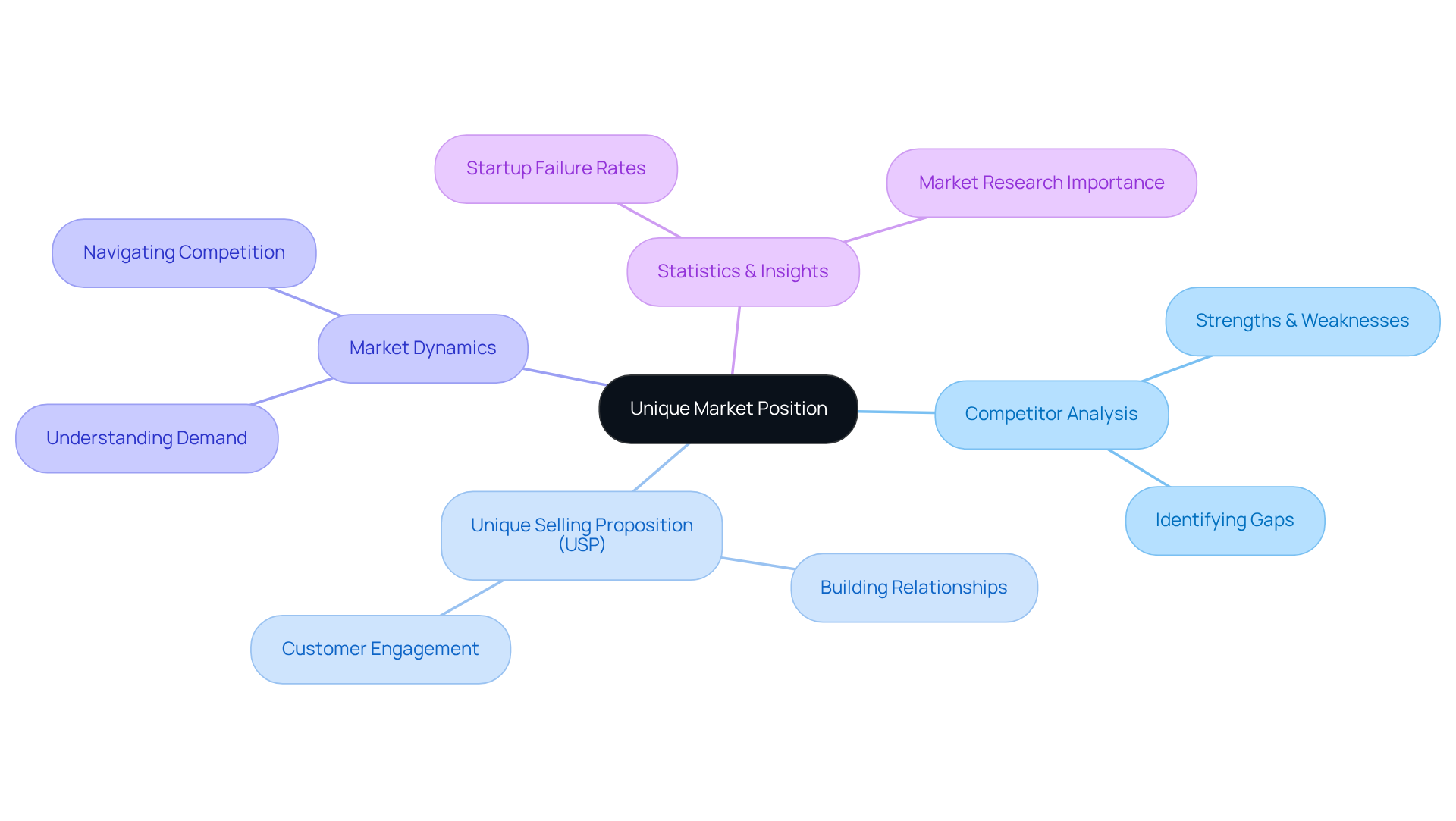
Craft a Compelling Brand Message: Communicate Your Value
poses a significant challenge for many tech startups. This message is not just a statement; it encapsulates your mission, vision, and values, and it needs to resonate deeply with your audience. Without this connection, it can feel like your voice is lost in a . Imagine the frustration of pouring your heart into your startup, only to find that potential customers overlook what truly matters.
However, there is hope. By embracing in the digital realm, as we've experienced with our partners RentMethod and , you can forge that . This approach not only clarifies and strengthens your but also highlights what makes your brand unique in a competitive landscape. For instance, after our , RentMethod experienced a remarkable 30% increase in user engagement. Similarly, Spring Labs saw a 25% boost in client retention rates. These successes illustrate that is not just about aesthetics; it’s about creating meaningful relationships.
By showcasing , you can help potential customers grasp not only what you offer but also why it truly matters to them. This understanding is key to fostering engagement and loyalty. Remember, you are not alone in this journey; we’re here to support you in crafting a message that resonates and connects with your audience on a deeper level.
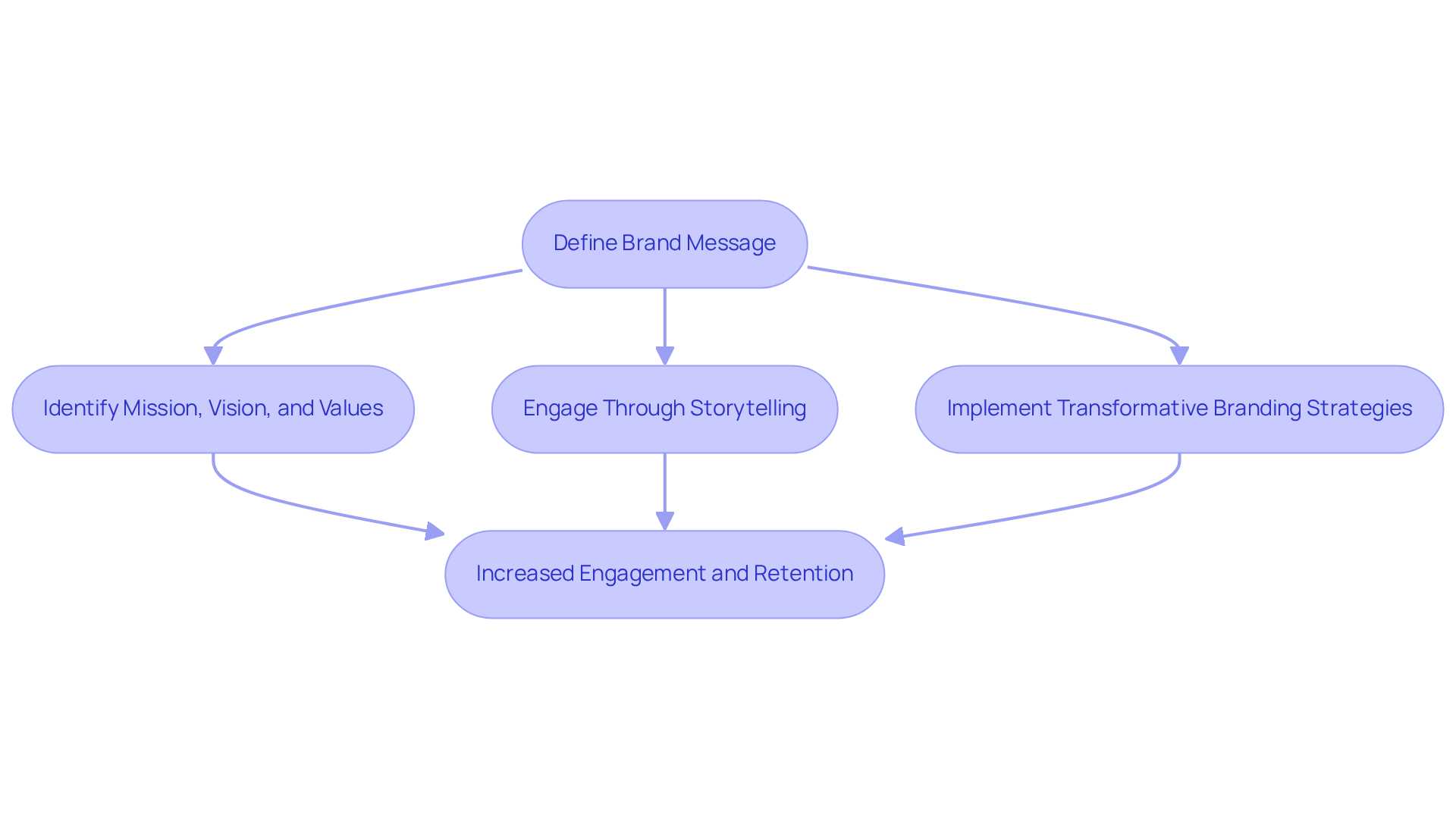
Develop an Engaging Visual Identity: Create Lasting Impressions
Creating an engaging can feel overwhelming for tech startups, as it is essential for establishing a cohesive design that truly reflects your essence. At RNO1, we understand the challenges you face, and we apply our nurturing design philosophy across every touchpoint to ensure that our solutions resonate deeply with your audience. This journey begins with developing a , serving as a visual anchor for your identity. By choosing a harmonious color palette and typography that embody your values, you enhance this identity further.
Consistency in these visual elements across all marketing materials not only boosts recognition but also cultivates a professional image that speaks to your audience. As Paul Rand wisely noted, '.' This highlights the vital role of intentional design in shaping perceptions and fostering relationships with clients. Successful examples in tech branding, like or the vibrant colors of Google, illustrate how cohesive design can leave lasting impressions and drive engagement.
Statistics reveal that a logo is the most critical tool in your promotional arsenal, underscoring the importance for startups to invest in . Moreover, case studies show that companies with strong visual identities enjoy higher customer trust and recognition, highlighting the importance of . To maximize your company's marketability, consider implementing , ensuring that your [visual identity](https://blog.rno1.com/9-essential-elements-for-an-effective-branding-deck) not only stands out but also fosters growth.
As a practical suggestion, regularly review and refresh your visual elements to keep your identity vibrant and relevant in a competitive market. Remember, you are not alone in this journey; RNO1 is here to support you every step of the way.

Leverage Technology: Enhance Your Branding Efforts
Tech companies often struggle to establish strong in today's overwhelming digital landscape, which can be challenging for many founders. This challenge not only affects visibility but also impacts the with their audience. of the Founder's Haven identity exemplifies how embracing digital tools can transform these challenges into opportunities. By optimizing their , RNO1 empowers modern founders to navigate these complexities with confidence through .
Utilizing social media for product promotion, employing , and leveraging CRM systems to manage customer relationships are all important ; they are lifelines. These tools can help create more by implementing effective branding strategies, fostering a deeper connection with the audience. Imagine the relief of knowing that your brand resonates with your customers, driving loyalty and growth.
By embracing technology, new businesses can cultivate a nurturing environment that prioritizes their audience's needs through . RNO1 stands ready to support founders on this journey, offering guidance and expertise to help them thrive in a competitive market. Together, we can create a community where every founder feels empowered to share their story and connect with their audience meaningfully.
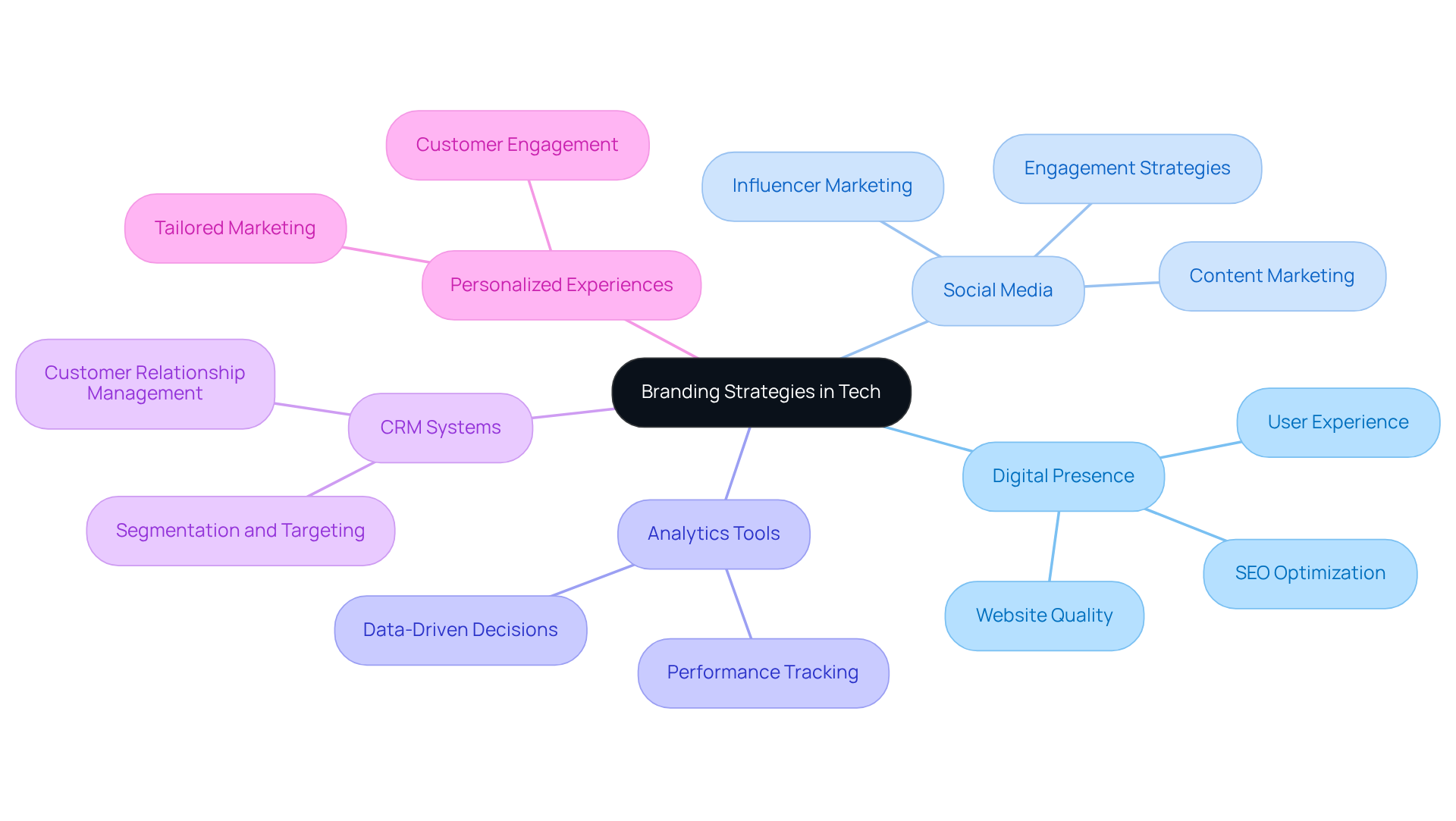
Analyze and Refine Your Strategy: Stay Relevant in a Changing Market
Regularly analyzing your is essential for tech startups, as it addresses a common concern. Many founders grapple with understanding how to effectively connect with their audience. This challenge can lead to missed opportunities and stagnant growth. Actively gathering client feedback, tracking industry trends, and assessing the impact of your promotional efforts are crucial steps in this process. For instance, companies that incorporate report a 25-30% rise in retention rates. This highlights the . Furthermore, businesses that harness customer feedback exhibit a 35% faster adaptation rate to market changes, enabling them to pivot quickly in a dynamic environment.
Utilizing this data can help you refine your approach, making necessary adjustments to your messaging, visual identity, and overall strategy. serves as a powerful example of how , boosting through influencer collaborations. By curating and executing national user-generated content initiatives and developing sales funnel sequences, new ventures can .
As Simon Mainwaring emphasizes, , which must resonate with your audience. This proactive approach not only keeps your business relevant but also ensures that your branding strategies evolve alongside customer needs and expectations. By adopting a culture of ongoing enhancement and utilizing influencer marketing, you position your venture for sustained success in a competitive landscape. Remember, you are not alone in this journey; by embracing , you can with confidence and compassion.
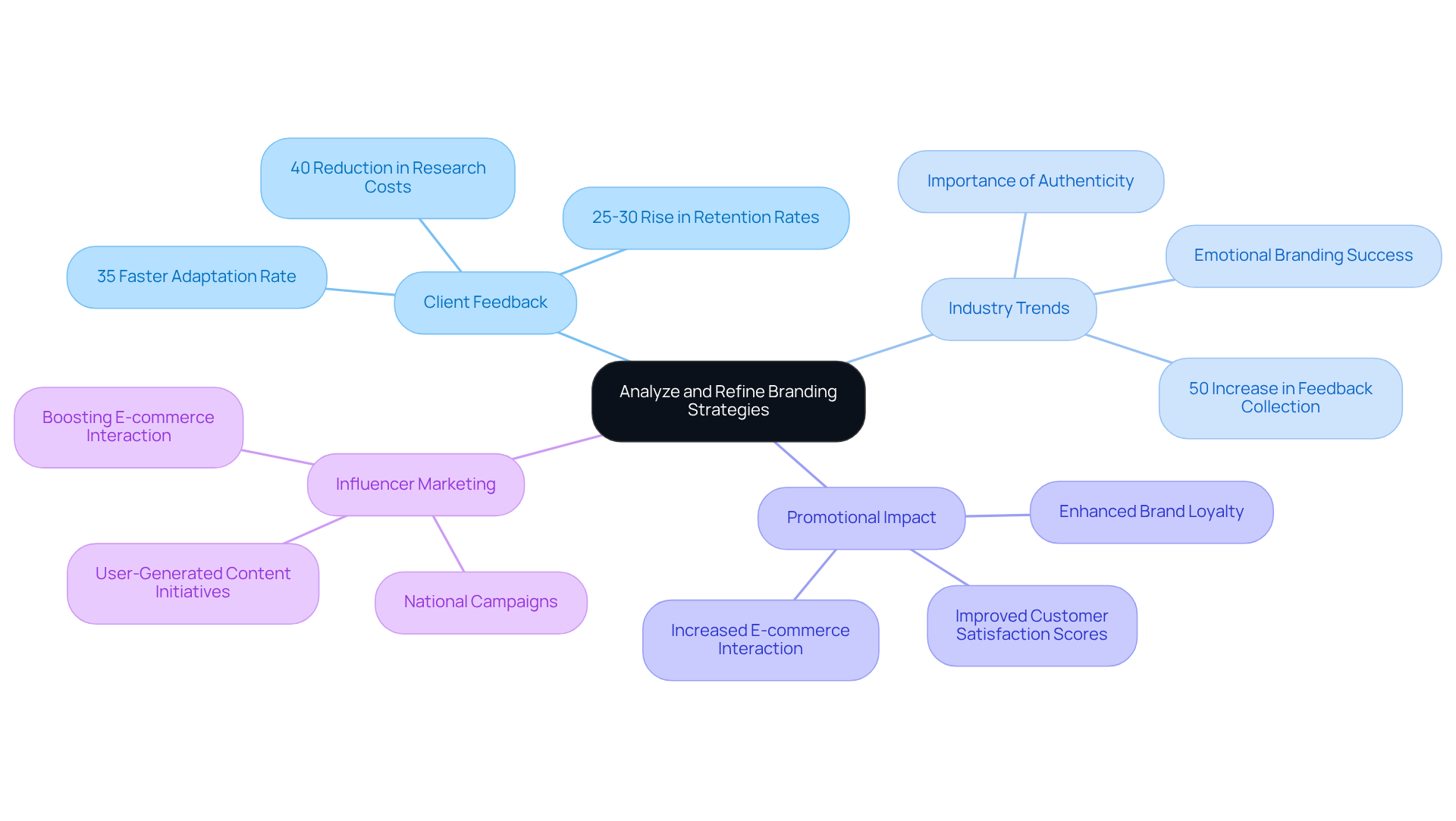
Build a Strong Brand Story: Connect with Your Audience
Creating an engaging narrative for is essential, as it expresses the journey, values, and mission of the enterprise in a way that resonates deeply with the audience. By sharing personal stories and the challenges encountered along the way, startups can weave narratives that not only engage clients but also and belonging. This connection inspires clients to become advocates for the company, enhancing its reach and influence.
Research shows that 92% of consumers prefer companies to communicate through storytelling, underscoring its and fostering loyalty. Successful examples in the tech industry, like LEGO's commitment to creativity and sustainability, demonstrate how a and retention. Furthermore, companies that effectively convey their narratives can see a 20% increase in consumer loyalty, as storytelling nurtures emotional bonds that resonate with buyers. When individuals enjoy a narrative, 55% are more likely to purchase the product in the future, highlighting the direct link between .
Incorporating storytelling into can significantly enhance . For instance, 64% of consumers are more inclined to make a purchase after viewing a branded social media video, showcasing the impact of visual narratives. Additionally, storytelling can , emphasizing the tangible benefits of this approach. By embracing these insights, technology companies can through that not only distinguish them in a crowded marketplace but also foster genuine connections with their audience.
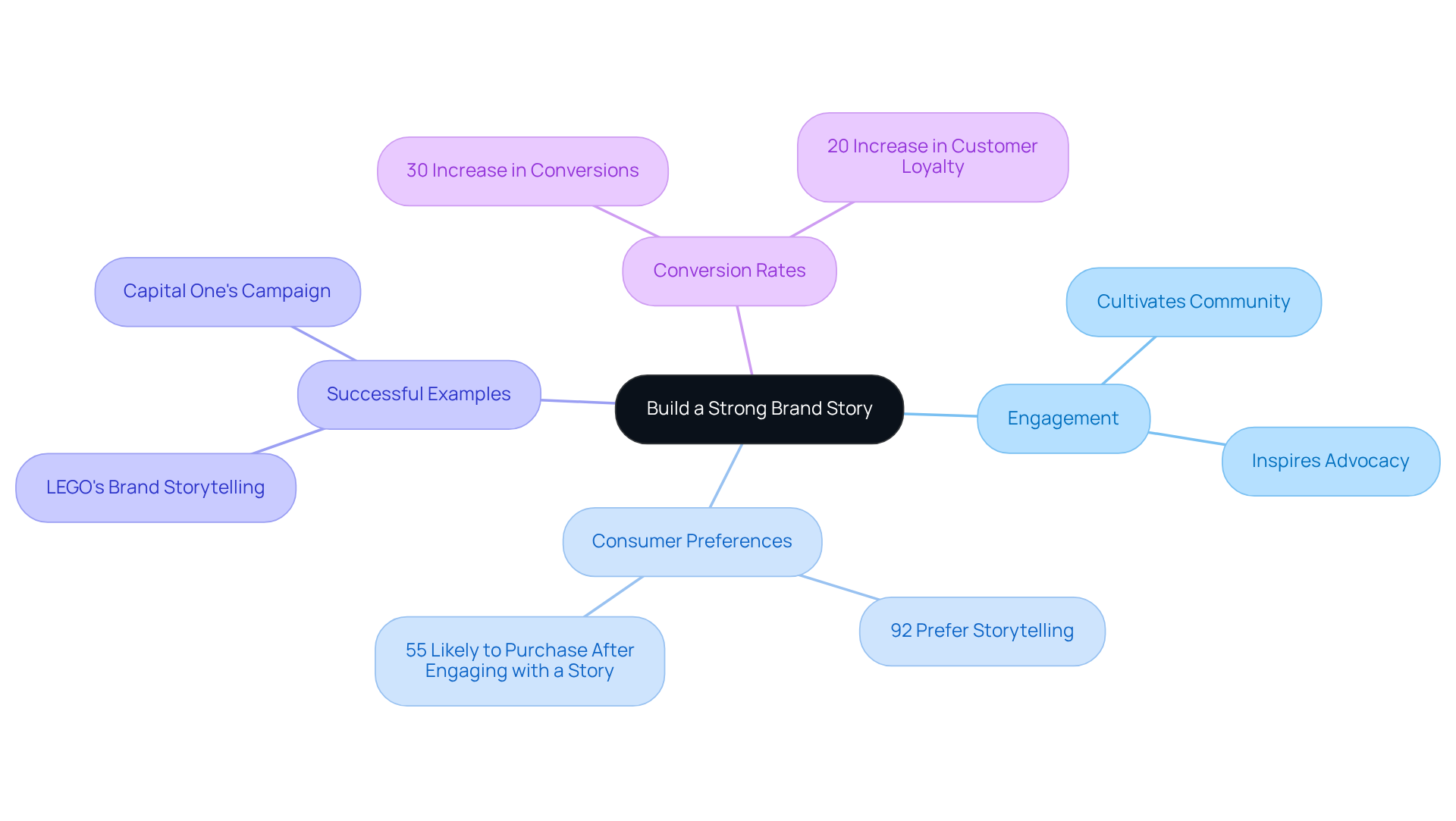
Establish Core Brand Values: Align Your Messaging
Establishing can feel overwhelming for many startup founders, yet it is essential for defining what your startup represents and how it wishes to be perceived by its audience. These values should not only encapsulate your mission but also serve as a guiding framework for all your . They influence everything from marketing campaigns to customer service interactions. When you consistently convey these values, you that fosters loyalty among consumers.
Research shows that . This underscores the importance of aligning your messaging with your core principles. For tech startups, in a competitive market, resonating deeply with audiences who seek authenticity and trust.
RNO1 exemplifies this nurturing approach through , such as with the , where reshaping digital identity and customer experience has driven innovation. Furthermore, inspiring case studies with Spring Labs and Amount reveal how has resulted in measurable improvements in and the expansion of omnichannel ambassador programs.
By embracing your core values, you not only enhance your branding strategies but also foster a supportive community that resonates with both your team and your customers.
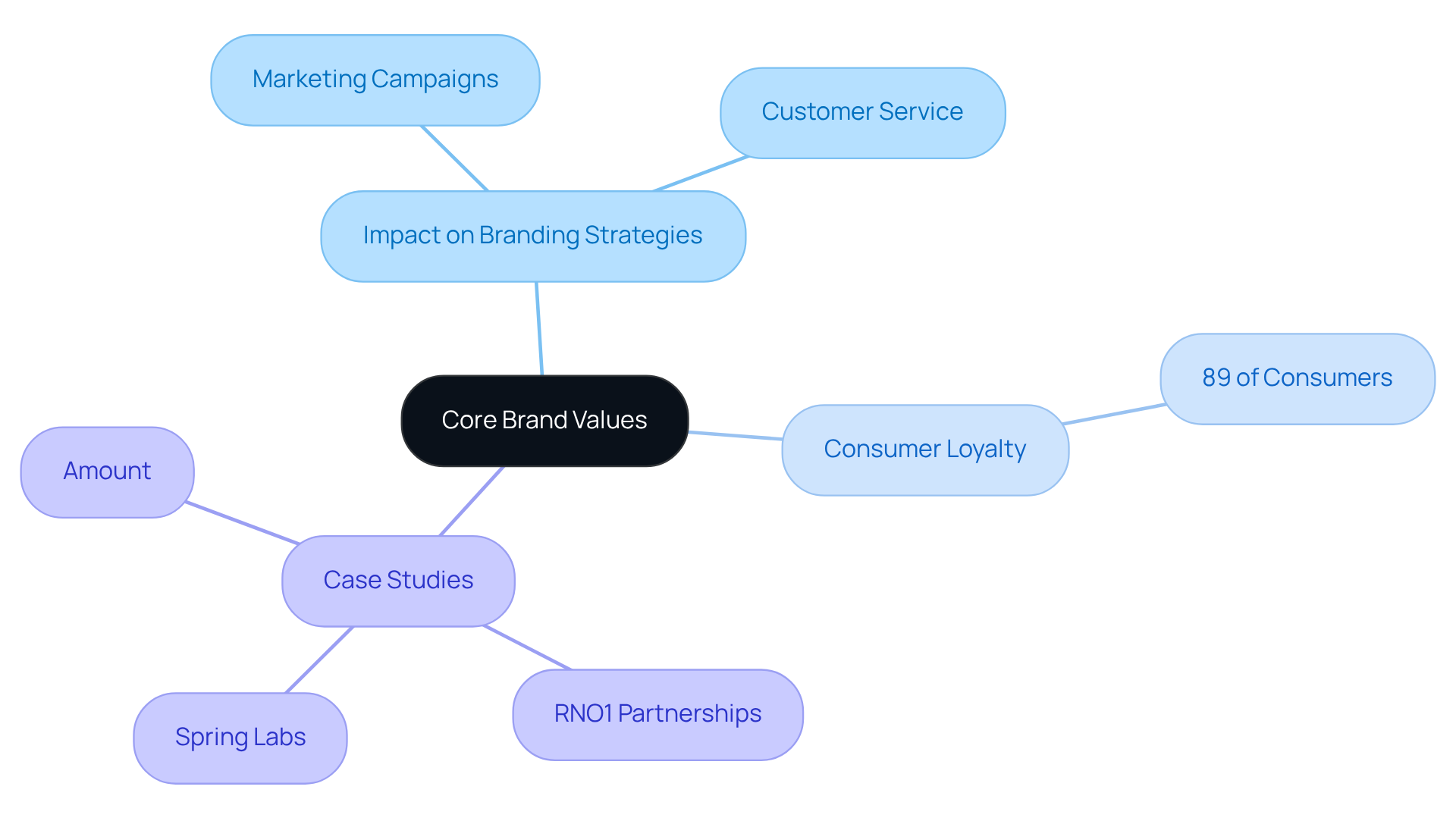
Maintain Consistent Voice and Tone: Ensure Brand Integrity
In the fast-paced world of tech startups, many founders face the challenge of utilizing to maintain a across various platforms. This inconsistency can lead to confusion and a lack of trust among your audience. It’s essential to develop guidelines that outline how your organization interacts with customers, partners, and the wider community. By defining the language, style, and emotional tone that reflect your core values, you can ensure that every piece of content—be it social media posts or customer emails—accurately represents your organization’s identity.
Educating your team on these guidelines is crucial. When everyone understands and embraces these principles, it guarantees that your messaging remains unified. This consistency fosters trust and recognition among your audience, which is vital for establishing in the competitive tech landscape. As Naimh Bennett aptly puts it, 'At its core, consistency in messaging is about presenting a unified message consistently, everywhere, to everyone.' Furthermore, a significant 68% of companies report that contributes to revenue growth, underscoring the importance of integrity in communication.
To support your efforts in maintaining this alignment, consider conducting regular audits of your . These audits can serve as a nurturing check-in, allowing you to reflect on your progress and make necessary adjustments. By prioritizing clear communication, you not only enhance your brand’s reputation but also create a supportive environment that resonates with your audience, ultimately leading to greater success.
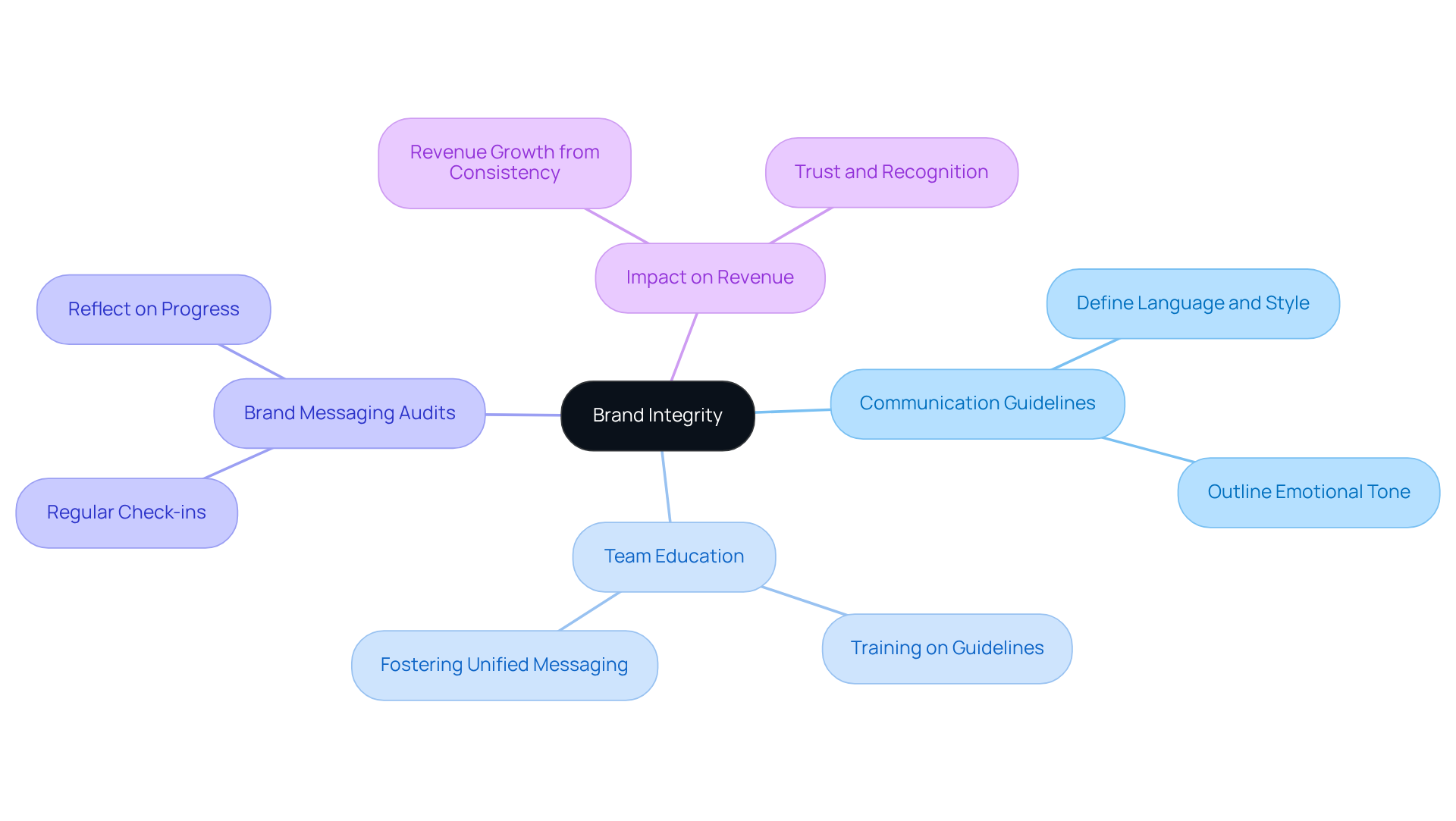
Conclusion
In a world where technology startups are blossoming, the challenge of establishing a compelling brand identity can feel overwhelming. Many founders grapple with the pressure of standing out in a crowded market, which can lead to feelings of uncertainty and doubt. However, this article shares nine essential branding strategies specifically designed for tech startups, emphasizing the importance of carving out a unique market position and connecting deeply with target audiences.
Understanding your audience is crucial, and thorough research is the first step in this journey. Crafting a unique selling proposition is not just a strategy; it’s a way to communicate your brand’s essence. Storytelling has the power to forge emotional connections with your customers, allowing them to see the heart behind your brand. Moreover, maintaining a consistent voice and visual identity is vital, as is leveraging technology to enhance your branding efforts. Each of these elements plays a significant role in fostering trust and loyalty, which are essential for long-term success.
As the tech landscape continues to shift, it’s important for startups to embrace these branding strategies and remain adaptable to the ever-changing market dynamics. By prioritizing authenticity, innovation, and engagement, you can differentiate your startup and build lasting relationships with your audience. While the journey of branding may present challenges, remember that with the right strategies in place, the potential for growth and success is truly boundless. You are not alone in this journey; together, we can navigate the path to a bright and successful future.
Frequently Asked Questions
What branding services does RNO1 offer for tech startups?
RNO1 offers a range of branding services specifically tailored for technology companies, including branding and identity development, website design, UX & UI design, SEO strategy & systems, and performance marketing strategies.
How does RNO1 support tech startups beyond initial branding services?
RNO1 provides ongoing support through innovative subscription models, ensuring that new businesses receive continuous guidance and expertise as they adapt to the evolving digital landscape.
Why is understanding the target audience important for technology ventures?
Understanding the target audience is vital as it helps technology ventures align their branding strategies with the specific needs and desires of their audience, enhancing the relevance of messaging and increasing engagement and conversion rates.
What tools can startups use to identify their target audience?
Startups can utilize tools such as online surveys and social media analytics to gather valuable insights about their audience's demographics, preferences, and challenges.
What is a Unique Selling Proposition (USP), and why is it important?
A Unique Selling Proposition (USP) is a clear statement that expresses the distinct advantages of a business compared to its competitors. It is crucial for attracting and retaining the target audience and enhancing customer engagement and loyalty.
How can competitor analysis benefit tech startups?
Competitor analysis helps tech startups identify gaps in the market by examining competitors' strengths and weaknesses, allowing them to uncover unmet needs that their products or services can fulfill.
What common pitfalls do new businesses face in the tech industry?
Common pitfalls include a lack of demand for their solutions, misreading market demand, and failing to align their products with consumer needs, which can lead to business failures.
What statistics highlight the importance of understanding market dynamics?
Statistics show that 35% of new business failures are linked to a lack of demand for their solutions, and 42% of new businesses fail due to misreading market demand, underscoring the need for effective market research.




